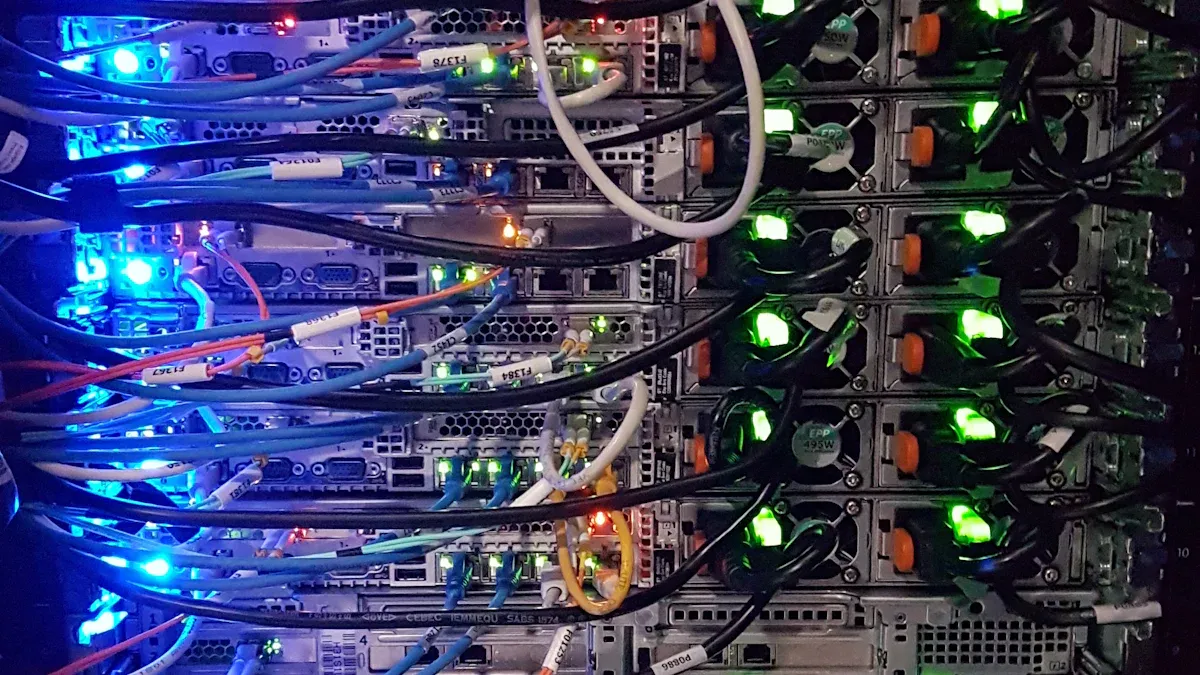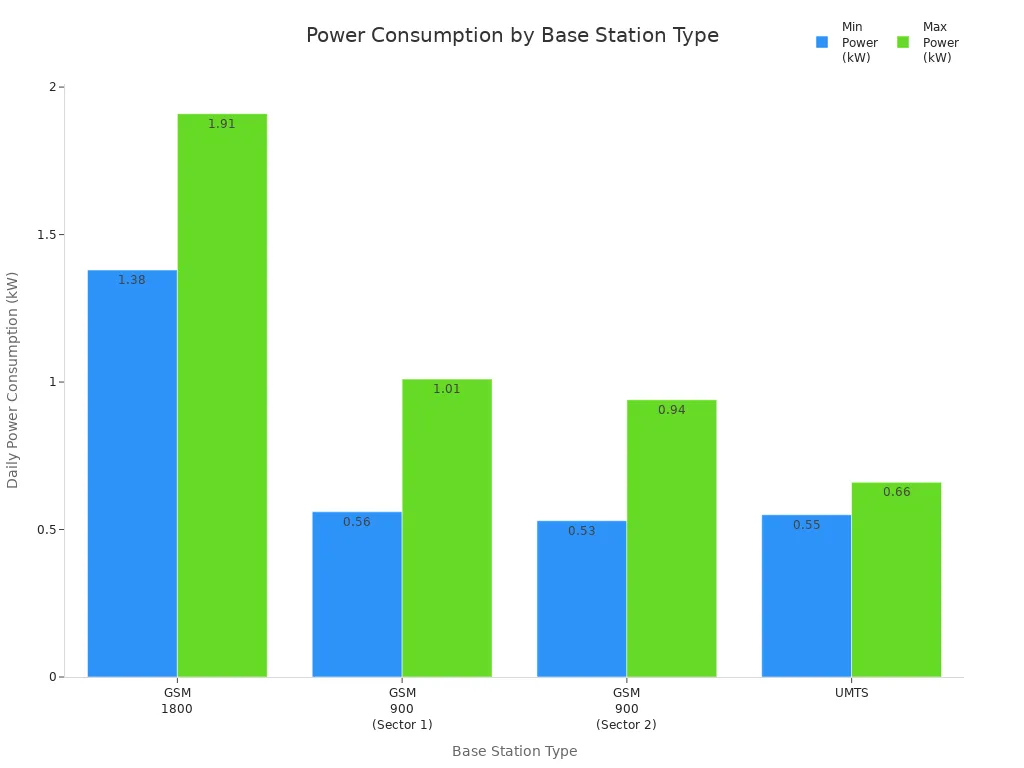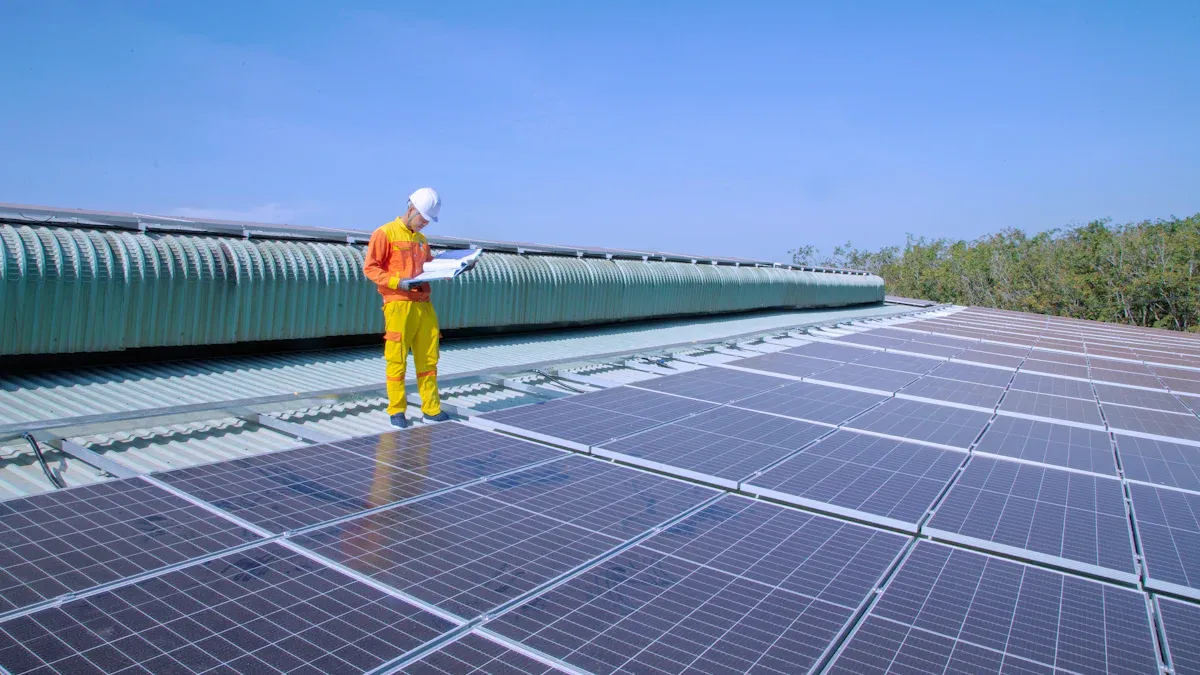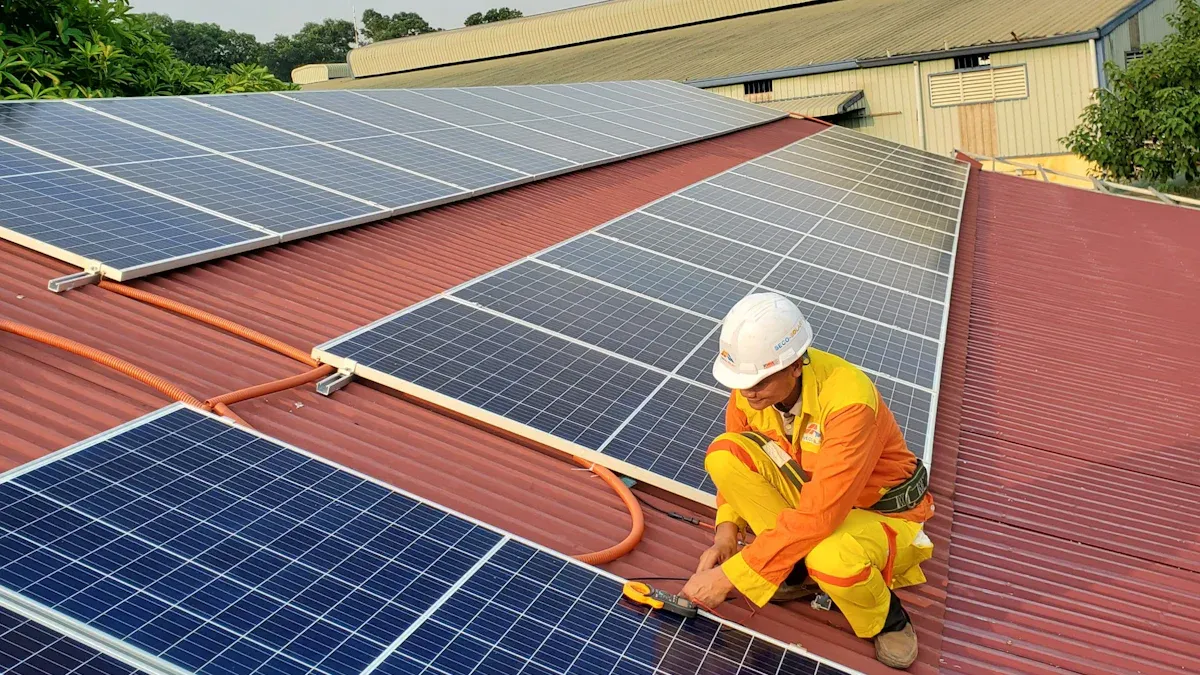What to Consider When Choosing ESTEL PV Panels for Telecom Cabinets

Choosing the right PV Panel for Telecom Cabinet is essential to guarantee that your solar systems provide uninterrupted power for telecommunications operations. A PV Panel for Telecom Cabinet delivers dependable energy for network equipment, particularly in remote or off-grid locations. It’s important to select a PV Panel for Telecom Cabinet that can endure harsh environments, ensure high reliability, and enable real-time monitoring. By opting for ESTEL, you benefit from alternative energy solutions that industry professionals trust. Utilizing a PV Panel for Telecom Cabinet not only reduces operational expenses but also enhances the resilience and reliability of your telecom infrastructure.
Key Takeaways
Assess your telecom cabinet's daily power needs carefully to size your ESTEL PV panel correctly and ensure reliable energy supply.
Choose high-efficiency ESTEL solar panels to maximize power output, especially when space is limited or sunlight is scarce.
Select durable, weather-resistant panels designed to withstand harsh conditions like strong winds, salt fog, and temperature changes for long-lasting performance.
Use non-invasive, rail-free mounting systems and ensure compatibility with your existing telecom equipment for easy installation and maintenance.
Consider the long-term value of ESTEL panels, including warranties, lower maintenance costs, and environmental benefits, to make a smart investment.
Power Needs Assessment
Understanding your power needs is the first step in selecting the right pv panel for telecom cabinet applications. Accurate assessment ensures your solar panel system delivers reliable energy to your networks, even in challenging environments. This process involves two main steps: calculating the load and sizing the pv panel for telecom cabinet use.
Load Calculation
You must determine how much electricity your telecommunication systems require each day. Start by identifying every piece of equipment inside your telecom cabinet. Each device, from routers to cooling fans, adds to the total energy demand. Follow these steps to calculate your power load:
List all hardware in your telecom cabinet to account for total energy consumption.
Estimate the power draw for each device. You can:
Add up the estimated output of each device.
Use real-time readings from built-in meters or faceplates that show voltage and current.
Calculate the total output for the entire rack and allocate it per device.
Apply the basic formula:
Power (Watts) = Current (Amps) × Voltage (Volts)For example, if a device draws 8 amps at 208 volts, the power is 8 × 208 = 1,664 watts.
Repeat this calculation for every device and sum the results to find the total power requirement for your cabinet.
Tip: Always include a safety margin to cover unexpected increases in energy use or future equipment upgrades.
The power consumption of telecom cabinets varies based on the type of equipment and network configuration. The table below shows typical daily power consumption ranges for different base station types:
Base Station Type | Number of TRXs | Typical Daily Power Consumption Range (kW) |
|---|---|---|
GSM 1800 | 12 (4 per sector) | 1.38 – 1.91 |
GSM 900 (Sector 1) | 7 per sector | 0.56 – 1.01 |
GSM 900 (Sector 2) | 7 per sector | 0.53 – 0.94 |
UMTS | 3 (1 per sector) | 0.55 – 0.66 |

These values change throughout the day as network traffic rises and falls. You should use the highest expected value to ensure your pv panel for telecom cabinet can handle peak loads.
PV Panel Sizing for Telecom Cabinet
Once you know your total daily energy requirement, you can size your pv panel for telecom cabinet use. The right size ensures your solar panel system provides enough electricity for your networks, even during cloudy days or seasonal changes.
You can use two main strategies to size your pv panel:
Consumption Strategy Formula:
PV Size [W] = Margin × (Daily Consumption [Wh]) / (Light Exposure [h])
This formula calculates the minimum solar panel output needed to meet your daily energy needs. The margin adds extra capacity for reliability.Battery Strategy Formula:
PV Size [W] = Margin × (Battery Capacity [Wh]) / (Desired Charge Time [h])
Use this approach if your telecom cabinet relies on batteries. It ensures your pv panel can fully recharge the battery within a set time.
A margin of 2x is common, but you may increase it for critical networks or harsh environments. For example, if your cabinet uses 1,500 Wh per day, you get 5 hours of sunlight, and you use a 2x margin:PV Size = 2 × 1,500 Wh / 5 h = 600 W
You would select a solar panel or combination of panels with at least 600 W output.
Note: Seasonal and geographic factors affect solar panel sizing. In regions with less sunlight or during winter, you need larger pv panels to maintain reliable energy output. Only cabinets exposed to direct sunlight require these adjustments.
A solar pv system designed for telecommunications must consider local weather, sunlight hours, and the specific needs of your on-site power sources. By following these steps, you ensure your pv panel for telecom cabinet delivers consistent electricity to your networks, supporting reliable telecommunication systems year-round.
Solar Efficiency and Technology

Panel Efficiency
When you select a solar panel for your telecom cabinet, you should focus on efficiency. Efficiency measures how well the panel converts sunlight into usable electricity. High efficiency means you get more power from the same amount of sunlight, which is crucial when you have limited space on or near your telecom cabinet.
A solar panel with high efficiency uses advanced pv cells that capture more solar energy. These cells often use special materials and designs to boost performance. You can see the impact of efficiency in several ways:
High-efficiency power distribution units (PDUs) reduce waste heat and improve transformer operation, which lowers energy consumption.
Intelligent PDUs with real-time monitoring help you spot and fix inefficiencies, balance loads, and schedule maintenance before problems occur.
Balanced loads prevent overheating, cut down on cooling needs, and extend the life of your equipment, so you get the most usable energy from your solar system.
Upgrading to intelligent PDUs improves Power Usage Effectiveness (PUE), which means your telecom cabinet runs more efficiently and costs less to operate.
Regular maintenance and monitoring of PDUs help you find energy waste and avoid equipment failures, keeping your telecom cabinet running smoothly.
Studies show that balanced loads and energy monitoring can cut energy use by up to 20%, which directly boosts your overall energy output.
Intelligent PDUs let you make data-driven choices that improve energy efficiency and system reliability, both of which are vital for telecom operations.
When you choose a solar panel with high efficiency, you maximize the energy your pv system delivers to your telecom cabinet. This means you can support more equipment or run your systems longer, even in areas with less sunlight.
Technology Innovations
Modern pv technology has seen rapid advances. These innovations help you get better performance and reliability from your solar panels in telecom cabinet settings. The latest solar panels use new types of cells, such as perovskite and multi-junction cells, which push efficiency rates above 20-25%. These cells capture more sunlight and convert it into electricity more effectively.
Performance Aspect | Improvement Description |
|---|---|
Energy Conversion | Advanced materials like perovskite and multi-junction cells increase efficiency, achieving over 20-25% conversion rates, providing more power for telecom cabinets. |
Real-Time Monitoring | Smart integration enables continuous performance tracking, reducing maintenance costs and improving energy output. |
Weatherproof Design | Durable encapsulation materials and robust designs protect against hail, wind, and thermal stress, ensuring system longevity in harsh environments. |
Downtime Reduction | Advanced monitoring and maintenance technologies reduce downtime by up to 70%, enhancing reliability of power supply. |
Maintenance Costs | Proactive maintenance scheduling lowers costs by approximately 25%, improving operational efficiency. |
Durability Testing | Panels withstand rigorous tests such as 96 hours of salt spray and hail impacts at 23 m/s, confirming resilience in diverse conditions. |
Recycling & Sustainability | Recycling initiatives reduce waste and conserve materials, supporting long-term environmental and system reliability goals. |
Innovations in pv technology improve your telecom cabinet’s performance by increasing energy efficiency through advanced cells. Smart real-time monitoring lets you track your solar panel’s output and spot issues early, which reduces maintenance and downtime. Weatherproof designs use tough materials that protect your solar panels from hail, wind, and extreme temperatures, so your system lasts longer. These improvements give you a stable and durable power supply for your telecom cabinet. Eco-friendly manufacturing and recycling practices also help you support sustainability and long-term reliability.
When you invest in the latest pv technology, you get more from your solar energy system. Advanced cells, smart monitoring, and durable designs all work together to keep your telecom cabinet powered, efficient, and reliable.
Durability and Environmental Factors

Weather Resistance
When you choose PV panels for telecom cabinets, you need to focus on weather resistance. ESTEL PV panels use advanced materials and engineering to protect your investment from harsh conditions. These panels undergo several tests to prove their durability:
Dynamic Mechanical Load (DML) testing checks if the panels can handle hurricane-grade winds.
Salt fog testing on marine-grade steel and epoxy coatings ensures corrosion resistance, even in high-humidity or coastal areas.
Real-world data from NOAA confirms that these panels perform well during hurricanes, hail, and tornadoes.
The use of marine-grade steel and strong coatings adds another layer of protection against corrosion.
These features help the panels maintain their performance and protect the sensitive cells inside. You can trust that your telecom cabinet will stay powered, even when the weather turns severe.
Temperature and Longevity
Temperature swings can affect the efficiency and lifespan of PV panels. ESTEL designs its panels with tempered glass and corrosion-resistant frames to withstand extreme temperature changes. The panels go through rigorous tests, including prolonged UV exposure and intense heat, to ensure long-term durability. They meet international standards like IEC 61215 and IEC 61730, which guarantee quality and a typical lifespan of 25-30 years.
Temperature changes influence the electrical output of the cells. As module temperature rises above 25°C, efficiency drops by about 0.30% to 0.45% per degree Celsius. Factors such as ambient temperature, solar irradiance, and wind speed all play a role. Panels with good ventilation lose less efficiency in hot conditions. New materials and cooling methods, like nanotechnology and passive fins, help reduce thermal losses and extend the life of the cells.
Factor | Description | Impact on PV Efficiency |
|---|---|---|
Temperature Coefficient | 0.30%/°C to 0.45%/°C (negative) | Efficiency drops as temperature rises |
Module Temperature Influencers | Ambient temperature, solar irradiance, wind speed | Higher temps reduce efficiency |
System Types | Ventilated vs. unventilated installations | Ventilated systems perform better |
Regular cleaning and inspections help you maintain the durability and performance of the cells over time.
Installation and Compatibility
Mounting and Steel Support
When you install a pv panel for telecom cabinet applications, you need a reliable mounting system. ESTEL recommends rail-free, non-invasive mounting systems for these projects. These systems offer several advantages:
You avoid drilling or cutting into the cabinet roof, which prevents leaks and structural damage.
Rail-free designs use direct-to-deck attachment points, making installation faster and simpler.
You reduce hardware complexity and lower both material and labor costs.
The lightweight, low-profile design puts less stress on the cabinet and looks more attractive.
These mounting systems withstand harsh weather, ensuring long-term performance.
Professional installation ensures proper waterproofing and structural integrity. High-grade steel support structures play a key role in durability and safety. Steel offers a strong strength-to-weight ratio, so your panels stay stable during wind or snow. Protective coatings like zinc-dust primers and phenolic coatings help prevent corrosion, especially in coastal or humid areas. When you choose steel that meets industry standards, you get a safe and reliable foundation for your solar power kits. Modular and precision-engineered steel structures also make installation easier and more adaptable.
Regular maintenance and following local building codes help maximize the lifespan and safety of your mounting system.
Integration with Telecom Cabinet
You must ensure that your pv panel for telecom cabinet matches the existing infrastructure. Start by checking that the voltage and current ratings of your panels, charge controllers, inverters, and battery banks all align. Modern charge controllers with MPPT technology adapt to changing input voltages, improving efficiency. Choose inverters with at least 95% efficiency and make sure they fit your system’s voltage and power needs.
Use weatherproof wiring and connectors to protect against energy loss and environmental damage. Place your panels for maximum sunlight and keep battery banks in ventilated, temperature-controlled spaces. Regular monitoring and testing help you avoid problems like overloading or underperformance.
Maintenance is also important. You should:
Keep the internal temperature stable with HVAC systems that offer remote control and dehumidification.
Use surveillance cameras to monitor the cabinet for any issues.
Inspect and clean the photovoltaic modules regularly.
Test electrical connections and repair or replace damaged parts quickly.
Maintain and cool inverters, checking their status and cleaning them as needed.
Monitor battery status and capacity, ensuring proper cooling and ventilation.
By following these steps, you ensure your pv panel for telecom cabinet integrates smoothly and operates reliably for years.
Cost, Quality, and Warranty
Cost vs. Value
When you evaluate PV panels for telecom cabinets, you should look beyond the initial cost. Many buyers focus on upfront price, but long-term value matters more for your investment. ESTEL PV panels may have a higher initial cost, but they deliver greater cost-effectiveness over time. You benefit from higher efficiency, longer lifespan, and reduced maintenance needs. These features help you lower operational costs and avoid frequent replacements.
Here is a comparison between low-cost inverters and high-value ESTEL inverters:
Factor | Low-Cost Inverter Characteristics | High-Value (ESTEL) Inverter Characteristics |
|---|---|---|
Initial Price | Lower upfront cost | Moderate to higher upfront cost |
Efficiency | Lower efficiency (85-90%) | Higher efficiency (95-98%) |
Maintenance | Frequent repairs and higher maintenance costs | Minimal maintenance costs |
Lifespan | Shorter lifespan (5-10 years) | Longer lifespan (15-25 years) |
Warranty | Typically 5-12 years | Extended warranty up to 25 years |
You should consider several factors when calculating the return on investment for your PV system:
Total system costs, including equipment, installation, and upgrades
Financial incentives such as tax credits and rebates
Projected energy production based on your site’s solar exposure
Trends in electricity prices
Maintenance costs and system longevity
Quality and efficiency of the equipment
Local energy policies and net metering options
Choosing ESTEL panels helps you save money over the product’s lifespan. Their advanced features, like AI integration and smart monitoring, further improve system reliability and maximize your savings.
Warranty and Support
Warranty coverage plays a key role in protecting your investment. ESTEL offers strong warranty terms for PV panels used in telecom cabinets. You receive a product warranty that covers defects in materials and workmanship for 10 to 25 years. The performance warranty guarantees at least 80% of the original energy capacity after 25 years. Installation warranties cover the quality of installation work for up to 10 years.
Warranty Type | Coverage Description | Typical Duration |
|---|---|---|
Product Warranty | Covers defects in materials and workmanship | 10 to 25 years |
Performance Warranty | Guarantees at least 80% of original energy capacity | After 25 years |
Installation Warranty | Covers quality of installation work | 1 to 10 years |
To keep your warranty valid, you should:
Keep all purchase and installation records
Schedule regular maintenance and inspections
Avoid unauthorized repairs or modifications
Contact ESTEL support before arranging repairs
Understand warranty exclusions, such as damage from animals or improper installation
Strong warranty support reduces your long-term risks and helps you control costs. You gain peace of mind knowing that your investment remains protected for decades.
Site and Environmental Considerations
Placement and Angle
You need to pay close attention to where and how you install your solar panels for telecom cabinets. The right placement and angle help you capture the most sunlight and generate reliable power. Follow these best practices to get the best results:
Survey your site to check for shading from trees, buildings, or poles. Make sure your solar panels get full sun between 9 a.m. and 3 p.m. all year.
Space rows of panels at least three times the height of a tilted panel to avoid shading between them.
Leave about 20% extra space around your panels for safe access and maintenance.
Use a compass to find the best direction. In the Northern Hemisphere, face panels south. In the Southern Hemisphere, face them north.
Set the tilt angle close to your site’s latitude. You can adjust the angle by 15 degrees for better performance in summer or winter.
Avoid placing panels on roofs that face away from the sun, as this reduces solar exposure.
If your roof is not suitable, consider ground mounting or solar trackers to follow the sun.
Keep DC cable runs short and secure your panels to prevent theft or damage.
Proper placement and angle help you avoid energy losses from shading, snow, or wind. Snow can cut solar output by up to 90%, so use steeper tilt angles and strong mounting systems to shed snow and handle wind loads.
Environmental Impact
Switching to solar energy for telecom cabinets brings major environmental benefits. You help reduce greenhouse gas emissions and support global sustainability goals. Many telecom operators have already seen big results:
Operator | Solar Initiative | Carbon Emissions Reduction |
|---|---|---|
T-Mobile | 100% renewable energy by 2022 | Large drop in carbon footprint |
Vodafone | 100% renewable energy in Europe | Major emissions reduction |
du | Solar on Tower Project | 3,750 tons less CO₂ each year |
Verizon | 50% renewable electricity by 2025 | Significant emissions reduction expected |
ESTEL’s solar systems lower your reliance on fossil fuels. You get steady power, even in remote or harsh locations. Hybrid solar designs let you scale up as your needs grow. You also spend less on maintenance and operations, which makes your system more sustainable. By choosing solar, you help meet the United Nations’ Sustainable Development Goals and show your commitment to a cleaner future.
To choose the best ESTEL PV panel for your telecom cabinet, follow a clear process:
Assess your power needs and site conditions.
Compare panel types using the table below:
Factor
Crystalline Silicon (c-Si) Panels
Thin-Film (TF) Panels
Efficiency
Lower (around 10%)
Cost of PV Module
Higher upfront cost
Lower upfront cost
Durability
Higher durability
Lower durability
Balance efficiency, durability, compatibility, and cost.
Consult ESTEL’s technical experts and resources for tailored solutions and ongoing support.
Regular expert guidance and maintenance help you achieve reliable, long-term performance.
FAQ
What makes ESTEL PV panels suitable for telecom cabinets?
You get panels designed for harsh environments. ESTEL uses durable materials and advanced engineering. These panels resist corrosion, extreme temperatures, and strong winds. You can rely on them for stable power in remote or challenging locations.
How do I maintain my PV panel system for telecom cabinets?
You should clean the panels regularly and inspect for damage. Check all electrical connections and mounting hardware. Use remote monitoring to track performance and spot issues early. Schedule professional inspections to ensure long-term reliability.
Can I upgrade my existing telecom cabinet with ESTEL PV panels?
Yes, you can upgrade most cabinets. ESTEL panels work with many telecom systems. You need to check compatibility with your current inverters, batteries, and mounting structures. Consult ESTEL experts for the best integration advice.
How does monitoring improve PV panel performance?
Monitoring lets you track energy output and system health in real time. You can detect faults quickly and schedule maintenance before problems grow. This approach helps you maximize efficiency and reduce downtime for your telecom cabinet.
What warranty coverage do ESTEL PV panels offer?
You receive product warranties from 10 to 25 years. Performance warranties guarantee at least 80% capacity after 25 years. Installation warranties cover workmanship for up to 10 years. Always keep records and follow maintenance guidelines to protect your coverage.
See Also
A Comprehensive Guide To Outdoor Telecom Cabinet Structures
Solar Energy Storage Solutions For Telecom Cabinet Power
Key Structural Design Standards For ESTEL Telecom Cabinets
Selecting The Ideal Mount For Outdoor Telecom Cabinets
Choosing The Most Effective Cooling System For ESTEL Cabinets
CALL US DIRECTLY
86-13752765943
3A-8, SHUIWAN 1979 SQUARE (PHASE II), NO.111, TAIZI ROAD,SHUIWAN COMMUNITY, ZHAOSHANG STREET, NANSHAN DISTRICT, SHENZHEN, GUANGDONG, CHINA


